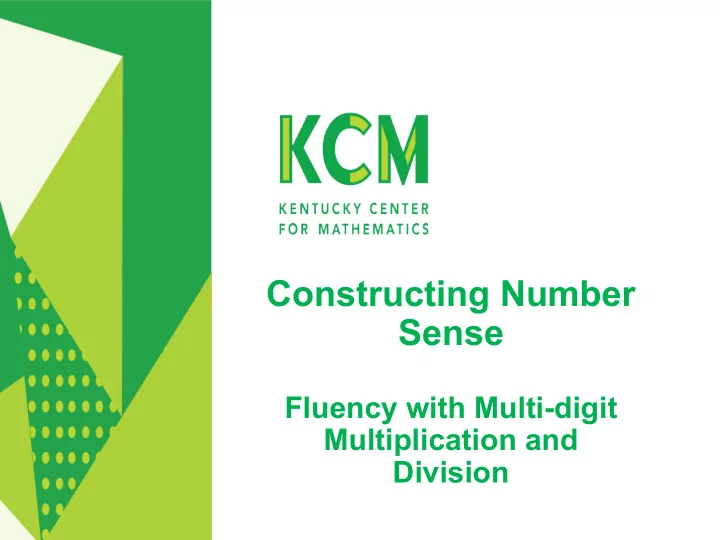

Constructing Number Sense Fluency with Multi-digit Multiplication and Division
Welcome! Your host: Belle Rush Regional Consultant Kentucky Center for Mathematics bsrush180@yahoo.com
Kentucky Center for Mathematics ● KCM seeks to advance the knowledge and practice of effective mathematics teaching and learning, encompassing early childhood through adult education. ● KCM provides and develops statewide leadership, facilitate professional learning experiences, and cultivate innovation with the aim of improving mathematics education, practice and policy. KCM Yearly Numbers
Visit Our Website www.kentuckymathematics.org
Agenda • What the research and standards say • A quick look at strategies • Arrays and area models • Partial products • Properties of operations, especially the distributive property • Games • Build It, Draw It, Prove It • Multi-Digit Multiplication Math Story Matching • Nice and Easy • Links to manipulatives, games, and explanations of strategies
What the research says…... Multiplication moves from the first year (in Grade 4) where the approach of the standard algorithm is developed and explained using visual models (diagrams) to the second year (in Grade 5) where the approach of the standard algorithm continues to be deepened and then is used fluently. The major issue for multi-digit multiplication is what to multiply by what and how the place values of the digits in the factors affect the place values of the partial products. An array or area model can help students understand these issues in terms of how the partial products are recorded. NCSM JOURNAL • FALL/WINTER 2012-2013
Critical areas for 4th grade In the Number and Operations in Base Ten domain, students will: apply their understanding of models for multiplication (equal-sized groups, arrays, area models), place value and properties of operations, in particular the distributive property, as they develop, discuss and use efficient, accurate and generalizable methods to compute products of multi-digit whole numbers;
What do the standards say? KY.4.NBT.5 Multiply whole numbers ● Up to four digit number by a one-digit number ● Two-digit number by two-digit number Multiply using strategies based on place value and the properties of operations. Illustrate and explain the calculation by using equations, rectangular arrays and/or area models. MP.3, MP.4, MP.8
Example of area model
Multiplication strategies
Useful explanations of strategies https://www.youtube.com/watch?v=wxE2Kur4AHc
Build It, Draw It, Prove It
● Turn arrow cards face down. ● Turn over one from each set to create a ● 3 digit number. ● Build that number using place value pieces.
● Draw your 3 digit number on the grid paper.
● Pick up a one digit arrow card. ● Build your original number that many times with place value pieces.
● Fill in the grid sheet, showing the total number.
● Write your equation to show how you got your answer.
Build it, Draw it, Prove it To play Build it, Draw it, Prove it: 1. Partner A draws an arrow cards from the hundreds, tens and ones pile 2. Partner A builds the three digit number using the base ten blocks 3. Partner A draws the model of the three digit number on the grid paper. 4. Partner A draws another arrow card this time from only the ones pile. This card is your multiplier. Partner A now has a 3 digit number times a one digit number. 5. Partner A draws the multiplication equation on the grid paper. (245 x 3) This shows the visual model of this multiplication equation. 6. Partner A solves the equation.
To play it with a partner Game: 1. Partner B repeats steps 1-6 2. One partner spins the more or less spinner. 3. Winner is the partner who is either more or less based on the spinner. 4. The winning partner gets a point 5. The winner is the partner who gets 5 points first.
● If playing with a partner, after each player has had a turn, spin to see if the player with more or less gets a point.
Lesson from KDE to make connections
Multi-Digit Multiplication Math Story Matching • Start with Set A, B, C • Match the story, area model and base ten card • Students justify their thinking • Then add Set D and E • Students justify their thinking
Halving and Doubling Strategy Click on images to play video
Nice and Easy (halving and doubling) • Player 1 roll the cubes. • Say aloud the multiplication sentence represented by the number cubes. • Draw that area model on the base ten grid paper and cut out.
Nice and Easy (halving and doubling) • Cut the area model in half to create a new multiplication equation. • Double one factor and half the other to figure out the equivalent multiplication sentence.
Nice and Easy (halving and doubling) • Place a counter on the matching multiplication sentence on the Nice and Easy game board. • Calculate and say the product and place a counter on the corresponding product on the Nice and Easy Too game board.
Modeling is the key to conceptual understanding.
Virtual Manipulatives https://www.didax.com/math/virtual-manipulatives.html
Toy Theater
Dreambox at home FREE for 90 days! https://www.dreambox.com/at-home
Visit Our Website www.kentuckymathematics.org
Upcoming Virtual Professional Learning
We are here to support our teachers! Your host: Belle Rush Regional Consultant Kentucky Center for Mathematics bsrush180@yahoo.com
KCM Support for Educators ● Kentucky Center for Mathematics is here to support our KY educators ● We are aspire to be a national leader in mathematics education # BetterTogether #TeamKCM
Recommend
More recommend